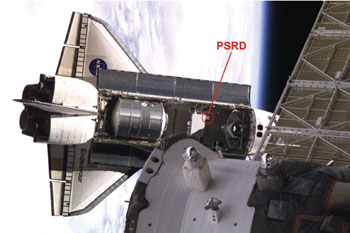Particle physicists involved in the Alpha Magnetic Spectrometer (AMS) experiment are eagerly scanning data recorded during a December 2001 NASA space shuttle mission.
When the space shuttle Endeavour blasted off from Cape Kennedy on 5 December 2001, its main mission was to switch crew and transport supplies to the International Space Station, but it was also the focus of a range of scientific studies. As part of the AMS development programme, the Endeavour carried as a “hitch-hiker” a Prototype Synchrotron Radiation Detector (PSRD). On the shuttle’s return to Earth on 17 December, the PSRD was shipped back to ETH Zurich. The data-storage disks were then read out and analysis of the results collected during the 110 h deployment window began.

The product of a major international collaboration masterminded by the 1976 Nobel prize winner Samuel C C Ting, many functions familiar from collider experiments will be incorporated into the AMS detector. It is the first major particle-physics detector to be sent into space; the prototype AMS-01 first flew on a shuttle in June 1998. Findings from last year’s flight will have a vital bearing on the final configuration of the full detector, which is being prepared for a mission aboard the International Space Station. The 3 tonne prototype developed in 1998 was impressive enough, but the final configuration will weigh approximately 6 tonnes.
A fundamental goal of the AMS experiment is to look for antiparticles in the primary cosmic radiation of outer space. Other objectives include searching for otherwise invisible “dark matter” and carefully analysing details of the cosmic-ray spectrum. The detector will therefore be equipped with a powerful superconducting magnet and sophisticated tracking capability.
When high-energy charged particles are bent by a magnetic field, they emit a “screech” of electromagnetic synchrotron radiation. The characteristic wavelength of this radiation can be used to identify the charged particles.
The Synchrotron Radiation Detector (SRD) will consist of an array of yttrium aluminium perovskite (YAP) crystals. Not available for 1998’s prototype mission, the new SRD technology is seen as an integral part of the final AMS configuration, mounted as the outermost layer of the complete detector. The energy- resolving power of the array depends on its size, but it is hoped that ultimately the SRD will be able to detect multi-TeV (1012 eV) electrons and positrons.
As well as monitoring the constant flux of cosmic rays in deep space, the AMS detector will be sensitive to special cosmic events such as the gamma-ray bursts now known to occur almost daily. These cataclysmic events are the largest explosions in the universe other than the Big Bang itself, but their origins are still a mystery. The extreme energies released in the bursts could provide new insights into the creation of matter and open up novel physics possibilities.
An imaginative theory proposed by John Ellis, Dimitri Nanopoulos and colleagues is the possibility that at this energy, the velocity of light could show a dispersion owing to quantum gravity effects. One objective of the SRD programme is to make careful measurements of the velocity of light under these conditions.








